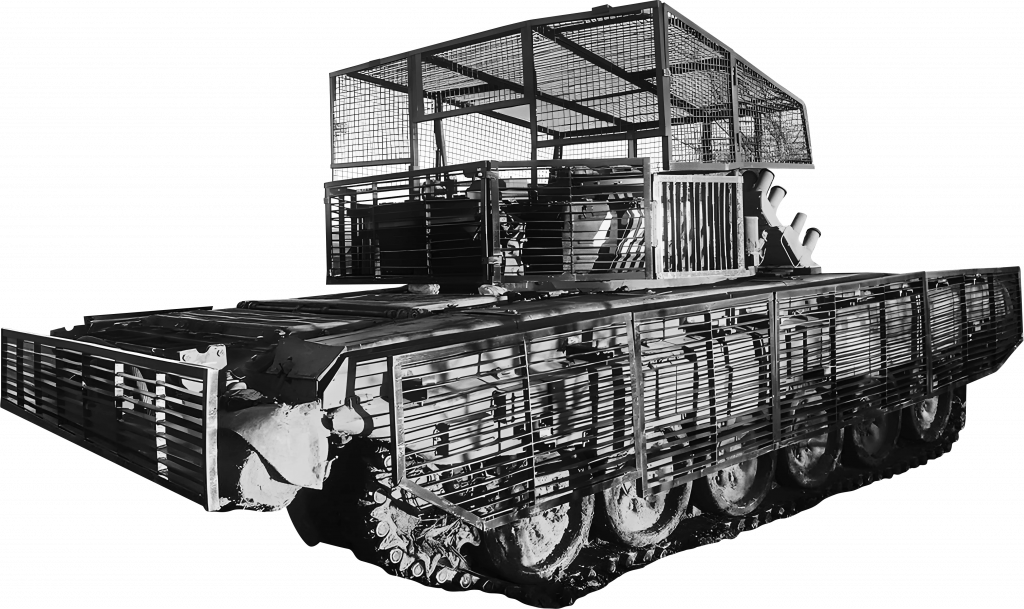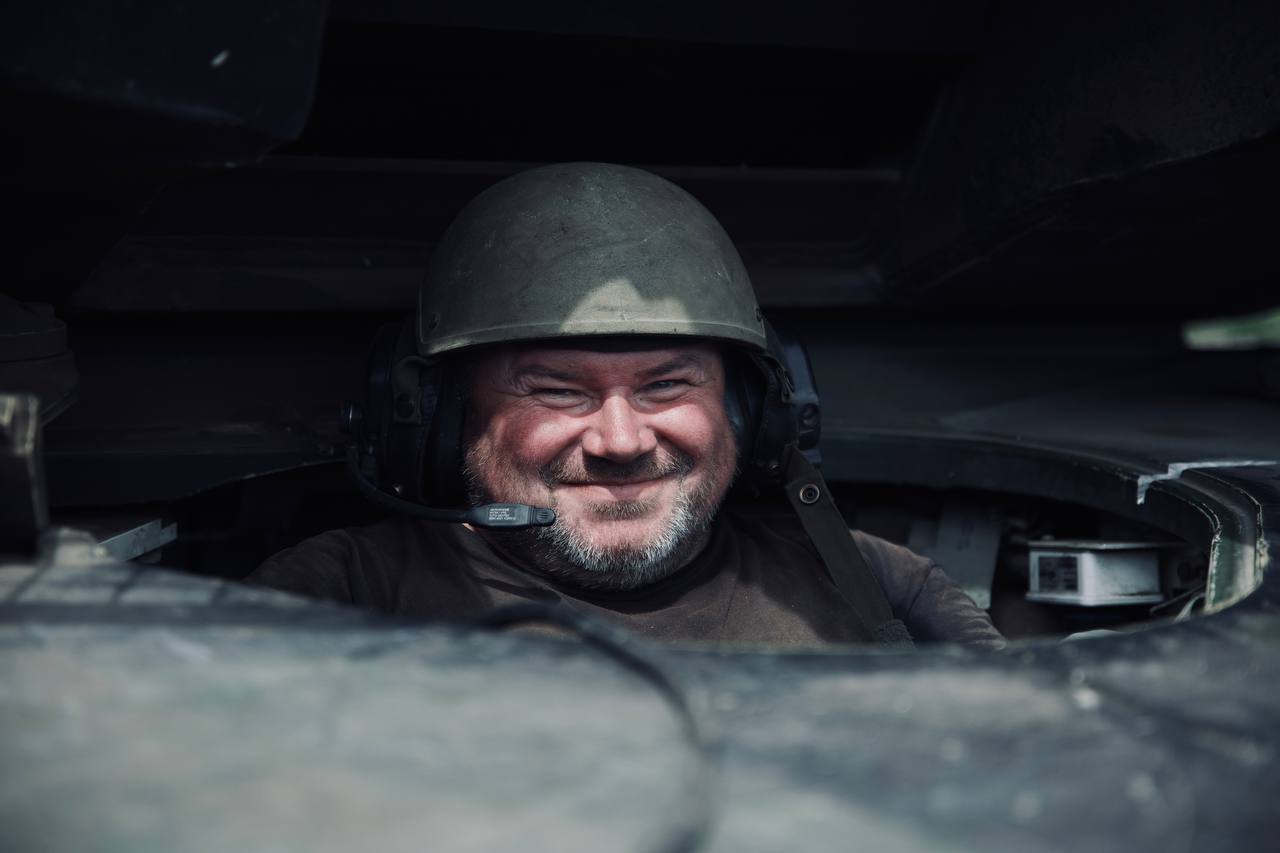Amid the full-scale war waged by Russia against Ukraine, the issue of protecting military equipment has become particularly relevant. Ukrainian engineers and manufacturers are not standing idly by and are developing new and effective solutions to protect the armed forces.
Metinvest Group mastered this area at the beginning of the full-scale invasion. As part of the Steel Front initiative, specialists have established the production of special steel and metal products that are used by the Ukrainian military. These include mobile special shelters, field stoves, armour plates for military personnel and equipment, Lancet catchers and more.
In a series of articles supported by Metinvest, LIGA.net will share the story behind the development of each of these products, the process of setting up production in Ukraine, their features, technical details and feedback from the military.
The first article is about protective screens for military equipment — a kind of “chain mail” for tanks.

Steel screens – An equipment upgrade to protect against drones
First-person view (FPV) drones, which the military has managed to adapt for combat operations, have become a new challenge in Russia’s full-scale war against Ukraine. Equipped with explosives, these kamikaze drones are able to identify vulnerabilities in military equipment and strike them. No wonder this war is called the “drone war,” as their applications are becoming more diverse and the pace of supply to both armies is accelerating.
As a result, both armies are looking for ways to protect against them. The Russian “sheds,” as they are popularly known, have become world famous. A tank is covered with metal plates for protection, giving the impression that the tank, having run into a rusty hangar, continues to move with it, much like a turtle moving its shell. This has led to other ironic name for such structures, such as “turtles.”
Despite its comical appearance, such protection increases the chances of survival for both equipment and people. The makeshift armour absorbs most of the force of the drone's explosion, protecting the fuel tanks and the soldiers behind it. However, the shed tank greatly loses mobility and manoeuvrability. For example, the turret is not able to rotate freely. Accordingly, the tank can only drive and fire straight ahead.
Ukrainian specialists took a different approach. Metinvest has developed steel screens — protective structures for military equipment that protect against FPVs, but do not limit the functionality of the combat vehicle. This solution also looks much better and neater than the Russian “analogues.”
The development of Ukrainian steel screens
The idea of manufacturing protective screens emerged as a result of the Steel Front’s constant communication with the military. Metinvest’s specialists, together with military engineers, analysed the most common areas where drones strike vehicles and developed appropriate protective structures based on the specifics of each model of tank.
Oleksandr Myronenko, the Chief Operating Officer (COO) of Metinvest Group, said: “Since the enemy primarily seeks to stop the equipment and then smash it to pieces, the task of the drones is at least to immobilise it. Our screens therefore act as nets that trap drones and prevent their contact with the hull of the combat vehicle. This allows it to save both the vehicle and its crew.”
The average weight of a tank screen grille is 430 kg, which is not much considering the weight of the tank itself. All the components are made of steel: metal structures for the frame, metal mesh and rolled sheets. This does not affect the manoeuvrability, speed and performance of combat missions.
Myronenko said: “The primary task of the screens is to protect the equipment without any restrictions on its functionality, the safety of the crew or manoeuvrability. That is why the screens are designed not to affect the functional component. Otherwise, their use would be unjustified and unnecessary.”

Testing at every stage
The development of the new product involved several stages: sketching, production of the first test model and testing. The product was then finalised and put into production. The entire journey from prototype to mass production takes between a week and a month. The steel screens undergo rigorous testing and trials before being sent to the front line.
The COO said: “From the first days of the war, Steel Front took on the responsibility of protecting our defenders. We are demonstrating this today by providing the AFU with modern anti-drone systems. Each tank equipped with our screens becomes stronger, and our soldiers receive additional protection.”
Currently, steel screens are used on the battlefield on Soviet-made T-72, Ukrainian T-64 and American M1 Abrams tanks as well as Bradley infantry fighting vehicles. The first protective screens for Leopard tanks have also been produced. Engineers are currently working on prototypes of such screens for the AFU’s lightly armoured vehicles.
Positive feedback from the military
The screens are installed at the AFU’s own repair facilities, and then the vehicles equipped with additional protection go to the zero line. It takes about 12 hours for a team of ten to 12 people to install one screen.
The cost of manufacturing one unit is up to US$20,000, which is a very small amount compared to the cost of a tank, especially the M1 Abrams, which costs over US$10 million.
The military is now receiving steel structures from the Steel Front initiative free of charge. Government orders for these products, the Group says, are a matter for the future. The Group’s production facilities, which produce steel screens and other steel products for the armed forces, are located outside of Metinvest’s enterprises at specially equipped sites in Ukraine. Their location is classified.

The developers receive positive feedback from the military.
Metinvest’s COO said: “The soldiers note that the survivability of the equipment increases by 30-40%. We have real cases when vehicles were stopped on the battlefield, but thanks to our screen, the crew remained alive and unharmed. They managed to get out, and the vehicle was later taken away for repair.”
Over a hundred steel screens are already in use by Ukrainian defenders. According to Metinvest, they have completed the development of protection for Bradley infantry fighting vehicles, which the US also donated to Ukraine, and for light armoured vehicles. As for plans for further production, it all depends on the army’s needs.
Myronenko said: “Military requests are always very specific and urgent, and they also change. This can be seen in the demand for bulletproof vests: in the first months of the full-scale invasion, the demand was huge, but later it decreased significantly.”
A historical overview –The evolution of screen protection
The idea of installing screens to protect military equipment is not new. Examples of their use date back to the First World War. Faced with the threat of German submarines, the British Royal Navy introduced the use of anti-torpedo nets. These massive steel nets were hung on the sides of large ships, particularly battleships and cruisers.
During the Second World War, screens were used to protect ground vehicles. In 1943, the German army introduced Schürzen, steel screens mounted on the sides of tanks. These “skirts,” as they were unofficially called, were designed to protect against anti-tank rifles and cumulative shells.
The Soviet Union also actively experimented with protective screens. Screens for KV and T-34 tanks were widely used, for example, during the Battle of Kursk in 1943.
During the Cold War, the development of protective technologies continued. The US experimented with composite screens for M60 tanks, which combined steel and ceramics to increase protection against cumulative ammunition.
In modern conflicts, the interest in protective screens was revived in the early 2000s, during the wars in Iraq and Afghanistan. The US Army developed the TUSK (Tank Urban Survival Kit) system for M1 Abrams tanks, which included lattice screens.
The British Army has also adapted its Challenger 2 tanks by introducing the Barracuda system. It not only provided physical protection, but also had camouflage properties in the infrared spectrum.
Modern developments in the field of military equipment protection include active protection systems that combine sensors, computing systems and physical screens.
Metinvest and Steel Front are learning from the close examination of the experience of other armies around the world to improve the products that protect Ukrainian soldiers. But the most valuable insights come from the front line, from the AFU, and these are helping to constantly improve the “chain mail” for the precious tanks that protect our even more precious defenders.
